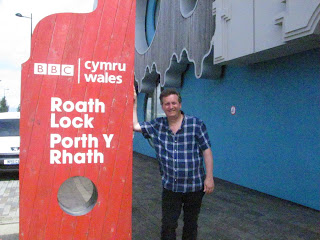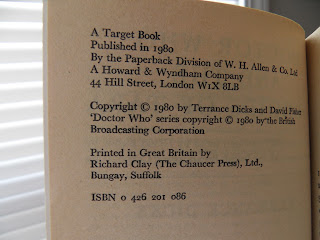I was tagged in a Facebook post today (On the
Doctor Who Collectors Group) about reprints of the Target
Doctor Who novelisations as some collectors were getting very confused about the reprints, how you could identify them and so on. And as it's a far more complex subject than you might imagine, and as Facebook is very transient, I thought it was worth putting some thoughts and explanations on the Blog so that they can be referred to going forward, maintained and updated with new information, and generally remain accessible to anyone who wants to know.
Throughout this piece I will refer to the Toybox site. This is an online resource for
Doctor Who collectors which attempts to catalogue every item of
Doctor Who merchandise ever released ... and of course this includes the Target Books. But also, for the Targets, we also tried to document every reprint we knew about or could find. It's not complete, but it's a pretty good starter for ten and also has cover images showing variances and so on ... so it's a good place to go.
www.doctorwhotoybox.co.uk
Okay. First things first. These are books, and books have an identifying number called an ISBN. This stands for International Standard Book Number, and is (or should be) a way to uniquely identify a given book. The rules say that every book should have a unique ISBN. If you change the book's format (ie it's physical size) or it's Cover Image, or it's content (significantly rather than minor corrections), or it's language, or it's publisher, or it's title then you should give it a new ISBN. The 'rules' can be found here if you're interested ...
https://www.isbn-international.org/content/isbn-assignment.
In practice, however, this doesn't happen, and you get all manner of things going on. But as a general rule of thumb, the ISBN for the Target books follows this pattern. So the first editions will each have their own ISBN. and that ISBN remains constant until they change the cover art ... most of the time.
If we look at the Book Covers now, and obviously each book has it's own cover. The first 12 books have the 'Block'
Doctor Who logo. Which looks like this:
They they changed it to the 'curved' logo like this ('The Giant Robot' was the first title to use this logo but that has Tom Baker's face over the 'O' so is not really representative):
:
Before moving on to the 'neon' logo:
Then the McCoy Logo:
And finally, to a totally different cover design for the last couple of books:
First editions (and we're talking first edition paperbacks here. Most of the Target books had hardback editions as well, some of which were published prior to the paperback editions, some of which were published at the same time as the paperback editions, but NONE of the hardbacks were badged as 'Target') will have specific colours for the logos and text, and these changed for reprint editions. So on the Toybox site, you will see that we try to highlight what is different or specific about which edition of the book. Some reprints changed the logo style as well, and also the artwork changed for a reprint ... but not always.
But be careful when checking cover colours and spine/back cover colours as they can fade and change to different colours with extended exposure to sunlight.
So usually you can initially spot what might be a first edition from the cover, the logo, and the colourings ... but there can be some other changes too ... You see that first edition cover of 'The Daleks' above? Well the tagline under the Author Name 'Based on the popular BBC television series' ... that line is missing off some of the reprints.
There's also part of the ISBN number printed on the first edition spine of the first three titles only, and this is missing off some of the reprints ... so you have to be observant and diligent to be able to spot a first edition.
The other good identifier on the books is the cover price. The books started at 25p each, but then rose in price, pretty much each year. So the price will give an indication as to which year the book originated from. And bearing in mind the confusion over the insides (see later) this is very helpful indeed.
Moving to the insides of the book, and the first thing to note is that these books were all produced back in the days when the covers and the insides were printed separately, and then brought together when the books were bound. What this means is that sometimes the publisher found themselves with stacks of covers, and no books to put in them ... or sometimes it was the other way round, they had lots of what are called 'book blocks' and no covers to wrap around them.
So what they would do, was to reprint either the covers or the insides so they could bind the books and get them out to shops. BUT when they did this, they sometimes made changes to the insides or the covers ... so you can have a first edition cover, with a second edition book block inside it ... or a first edition book block with a reprint edition cover around it.
Another aspect of this is rejacketing, where older copies of the book would have their jackets removed ('stripped off') and a new jacket put in their place. This happened when there were large numbers of stocks of a book in the publishers warehouse, and the publisher wanted to perhaps increase the jacket price on them, or to change the jacket for a new illustration or branding, thus refreshing the stock and allowing it to be sold ...
This makes it VERY hard to try and definitively pin down what edition is what ... there are so many changes!
Another point to note is that when covers were reprinted, they sometimes didn't go back to the original plates and artwork, and instead used a previous cover to reprint from. This means that some subsequent reprint covers are 'zoomed in' and lack detail. Also the colours can be harsher ... all these things are because they just took an earlier cover and used that as the basis for the new reprint.
Look at page 4 of a given book, and you will find the publishing information. This is supposed to tell you which edition it is, and sometimes publishers will print in it 'Second Edition' or 'Reprinted 1996, 1997 (twice), 1999' or whatever to show which this copy is. Another way this is done is by printing a sequence of numbers like this '2 4 6 8 9 7 5 3'. That sequence would indicate a second edition as the '2' is the lowest number there ... Others might have '3 4 5 6 7 8 9 10 11 12' which would indicate a third edition as '3' is the lowest number there.
Here's an example of a First Edition Target:
You can see that it DOESN'T SAY it's a first edition. Some books will however note this.
Here's the same page from a reprint edition:
You can see the FIRST PUBLISHED information, and that it also says SECOND IMPRESSION and REPRINTED IN ... So this is possibly a second edition, or possibly a third edition (the information can be interpreted to mean that the Second Impression was then reprinted again ... making this a third impression).
However, sometimes they didn't update the information on this page when they reprinted, meaning that while the cover might have been different, with a different price, the insides remained the same.
Here's another example of a reprint interior:
Here you can see the four reprints are noted.
If you look on the Toybox site, you'll see that some of the books have loads and loads of reprints, while others have very few indeed, and some have none! This is simply because as the range continued, the publishers learned how many to print, and if they got their sums right, then no reprint was ever needed. Especially too as they got to the end of the range, when they knew that they couldn't afford to end up with loads in stock ... Again, the print runs, where known, are noted in the Toybox listings.
I think those are the main points ... to summarise:
Check the cover:
- Is the logo correct
- Is the colour correct
- Is the cover image correct
- Is the cover price correct
- Is the ISBN correct
Check inside:
- Does it indicate any reprint editions?
- Is the ISBN the same as the cover?
If all these are confirmed, then congratulations, you probably have a first edition!



































